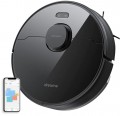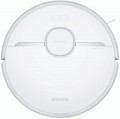The suction force provided by the vacuum cleaner. It is indicated by the maximum vacuum (negative pressure) that the unit can create at the working nozzle.
Note that this parameter is sometimes confused with the suction power described above, which is indicated in watts. Yes, suction force to some extent determines the efficiency of the unit. However, this efficiency also depends on the performance (airflow). And the suction power, indicated in watts, takes into account both of these parameters — it is determined by multiplying the suction force by the performance (see above for more details). For this reason, there is no strict relationship between this force and suction power: for example, a vacuum of 25,000 Pa can be found in models with 250 W, 200 W and even 150 W of power.
As for the practical significance of this spec, in general, a higher suction force allows you to work more efficiently with high resistance. For example, when processing carpets with a long pile. On the other hand, more pascals (with the same number of watts) means less airflow and, accordingly, less efficiency for large amounts of work at low resistance (for example, cleaning large rooms with parquet floors). Thus, it makes sense to pay attention to this indicator mainly in cases where high suction force is fundamental for you. In other cases, it is worth evaluating the capabilities of the vacuum cleaner in terms of suction power in watts.
Note that for a number of
...reasons, the suction power is most often specified for robot vacuum cleaners (see “Produc type”). For such models, a value of 1500 Pa and below is considered very small, 1500 – 2000 Pa — medium, 2000 – 2500 Pa — high, more than 2500 Pa — very high.
It is also worth mentioning that the indication of suction force is often used as a publicity trick — to improve the impression of the product. For example, the suction power of 150 watts in itself is quite modest. But at the same time, the suction force of such a vacuum cleaner can be 25,000 Pa — a very impressive figure, especially for an inexperienced buyer, but having a very indirect relation to real efficiency. Especially often, such tricks are used among upright models and the already mentioned robots — these varieties initially do not differ in high power in watts. For many of these units, the characteristics only indicate the vacuum in pascals without specifying the suction power. It further enhances the impression: for example, in the specs of a modest robot, the figure "3000 Pa" looks much more impressive than "40 W". However, such figures have a very weak relation to the real capabilities of the unit and if they are not supplemented by data on suction power in watts, they should be considered solely as bait for a not particularly sophisticated buyer.Advanced models of robotic vacuum cleaners can have
multi-map memory. Thanks to this feature, when moving the robot to another floor, it does not need to reacquaint itself with the premises and build a new map. As a result, cleaning will be done faster and better.

